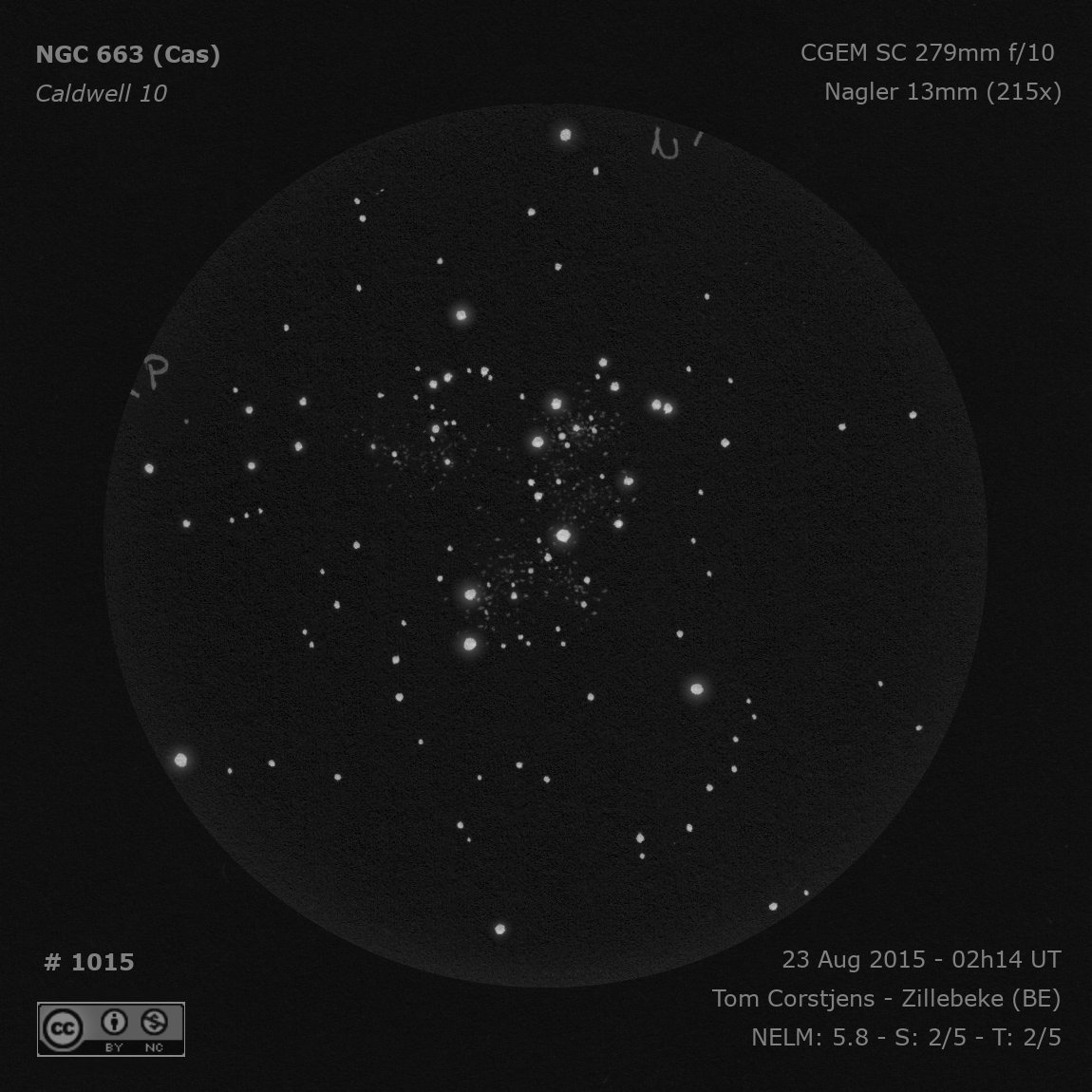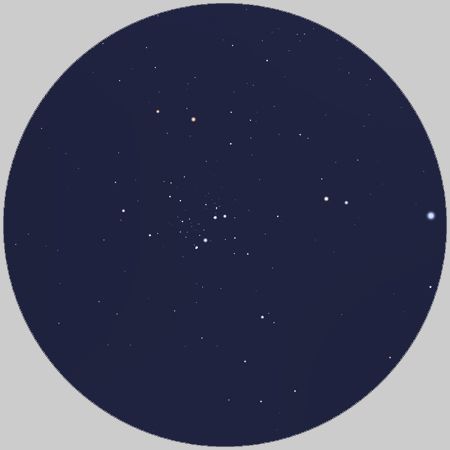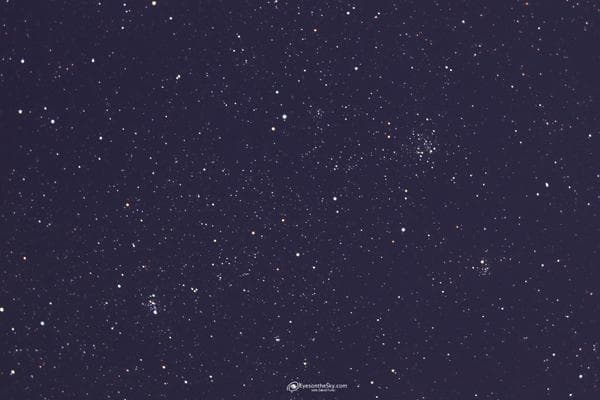NGC 663
A detailed guide to finding / observing the open cluster
TOTS #4 is a detailed written and video reference to finding and observing the open cluster NGC 663 in the constellation of Cassiopeia. This guide is ideal for beginners, but many advanced amateur astronomers may find it useful. Note that NGC 663 is sometimes called the "Lawnmower Cluster." This guide will help you locate this open cluster whether your telescope has a magnified finderscope or a red dot finder.
Visitors who are new to this site may wish to get started here or if you are already familiar with telescopes and equipment but aren't sure where to get started, check out the Shapes in the Sky section on this site. The Cassiopeia video in particular will help you get in the right area of the night sky to locate this object.
Find NGC 663 in the sky
NGC 663 is an open cluster within our own Milky Way galaxy. It is over 6,800 light years from Earth, so the photons from it reaching your eye in a telescope left that cluster about the time circular ditches - such as the Goseck Circle - were being dug as solar observatories in the 5th millenium BCE. NGC 663 is stil considered a young open cluster, with an estimated age around 20 million years. Here is how to locate it.
Observing tips:
This is a good cluster for helping the observer understand what kind of viewing conditions they have, and what magnitude of stars their telescope will reveal. NGC 663 is only 16 arc minutes across in total, or just over 1/4 of a degree. So higher magnification will help in a couple of ways; one, it will frame the cluster nicely at a 1/2 to 2/3 degree field of view, and two, the higher power will darken the sky background, often assisting in revealing more stars.
How many more stars? There are about 10 of them that are 9-th to 10-th magnitude. That alone makes the cluster worth finding. These will be the easiest to find and see from most anywhere. But at 11-th magnitude (down to 11.4), close to 20 more can be seen. Add a bit more aperture, and for 12-th magnitude, and as many if not more are now observable. A 6" telescope at 100x to 150x magnification under reasonably dark suburban skies can show a lovely cluster and stars down to 13.5 magnitude, make this a magnificent sight.
So aperture and magnification will help. Use both as you can, just don't overdo the magnification.
Useful filter(s): Broadband light pollution filters may be useful in moderate to larger sized telescopes (114mm or larger) but only to darken the sky background at lower magnifications. The filter will also dim the brightness of the stars, so the benefit may be minimal or non-existent.
What should I see?
Photographs show much more of night sky objects because they can capture more photons for longer periods of time. As such, sketches of deep sky objects are perhaps one of the better ways to see what you might expect to observe at the eyepiece, because it is a rendering of what another observer's view was. This sketch is by Tom Corstjens, from a 279mm (11") telescope. While larger than many beginner telescopes, it provides a good idea of what may be visible under darker skies or with equipment 150mm/6" or larger too.

Sketch by Tom Corstjens. Used with permission and via the Creative Commons Attribution-NonCommercial 4.0 International license. To see more of his sketches, follow Tom on Twitter.
Because telescopes and observers are all different, here are some alternate sketched / drawn views of NGC 663:
Jeremy Perez, 6" f/8 at 120x
Mike M, 16" at 84x
Below is an approximate view of NGC 663 as seen with a 70mm telescope at 60x magnification, and a 0.9 degree telescopic field of view.

Graphic demonstrates how view would look with objects on the meridian using a refractor telescope and a star diagonal. Other telescopes or object sky positions may incur a differing view. Various magnifications, eyepieces, telescope focal lengths and other variables may alter the view compared to this one. This is a representation only intended to help the observer get some idea what they may see at the eyepiece. Extreme local light pollution may block the view entirely.
Details of NGC 663
Type: Open star cluster
Distance: 6,850 light years
Apparent dimensions: 16 arc minutes
Apparent magnitude: 7.1
Right ascension: 01h 46m 0.0s
Declination: +61 15' 00"
Here are some other nearby Telescopes On The Sky objects you can find and observe with any small telescope:
Double Cluster (open cluster)
More about this constellation
Name: Cassiopeia
Abbreviation: Cas
Genetive form: Cassiopeiae
Common names: The Queen, Ethiopian Queen
Associated asterisms: Five brightest stars form a "W" or "M" shape depending on the time of night/year
Original 48 of Ptolemy: Yes
Area by size: 598 square degrees
Relative size: 25 out of 88 (Perseus is next larger, Orion is next smaller)
Telescopes On The Sky objects that can be found in this constellation: Eta Cassiopeiae, NGC 663, NGC 457
Brightest stars, in order of magnitude
First lists the Bayer designation, then the "traditional" star name (often Arabic, but not always - see each star's notes for details).
-
α (Alpha) Cassiopeiae (Schedar, Shedir) magnitude 2.25, the 71st brightest star in the sky. The traditional name is derived from the Arabic word صدر şadr, meaning "breast," appropriate for a queen constellation.
-
β (Beta) Cassiopeiae (Caph) magnitude 2.27, is the 73rd brightest star in the sky. Its name comes from a pre-Islamic Arabic term al-Kaff al-Khadib which means "the stained hand" (referring to stain from henna). .
-
γ (Gamma) Cassiopeiae (Tsih, Navi) magnitude 2.39, is 82nd brightest star in the sky. However, it is also somewhat variable, dropping as low as 3.0, and as bright as 1.6. The star has no traditional Arabic name. "Tsih" comes from Chinese, derived from the word "whip." A nickname was applied to the star by American astronaut Gus Grissom; his middle name was "Ivan" and spelled backwards, it is "Navi."
-
δ (Delta) Cassiopeiae (Ksora, Ruchbah) magnitude 2.68. It is an Algol-type eclipsing variable star, with a period of 2 years/1 month, and varies by 0.1 magnitude. The traditional names are from the Arabic word ركبة rukbah meaning "knee."
-
ε (Epsilon) Cassiopeiae, magnitude 3.35. It has no traditional Arabic name assigned to it.
-
η (Eta) Cassiopeiae, magnitude 3.45. It has no traditional Arabic name assigned to it. It is a very Sun-like star in size, mass and luminosity.

